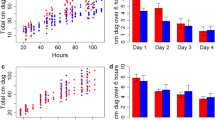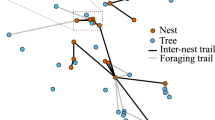Abstract
Trail-making ants lay pheromones on the substrate to define paths between foraging areas and the nest. Combined with the chemistry of these pheromone trails and the physics of evaporation, trail-laying and trail-following behaviours provide ant colonies with the quickest routes to food. In relatively uniform environments, such as that provided in many laboratory studies of trail-making ants, the quickest route is also often the shortest route. Here, we show that carpenter ants (Camponotus rufipes), in natural conditions, are able to make use of apparent obstacles in their environment to assist in finding the fastest routes to food. These ants make extensive use of fallen branches, twigs and lianas as bridges to build their trails. These bridges make trails significantly longer than their straight line equivalents across the forest floor, but we estimate that ants spend less than half the time to reach the same point, due to increased carriage speed across the bridges. We also found that these trails, mainly composed of bridges, are maintained for months, so they can be characterized as trunk trails. We suggest that pheromone-based foraging trail networks in field conditions are likely to be structured by a range of potentially complex factors but that even then, speed remains the most important consideration.



Similar content being viewed by others
References
Andersen SB, Ferrari M, Evans HC et al (2012) Disease dynamics in a specialized parasite of ant societies. PLoS One 7:e36352
Andersen SB, Gerritsma S, Yusah KM et al (2009) The life of a dead ant: the expression of an adaptive extended phenotype. Am Nat 174:424–433
Azcarate FM, Peco B (2003) Spatial patterns of seed predation by harvester ants (Messor Forel) in Mediterranean grassland and scrubland. Insectes Soc 50:120–126
Beckers R, Deneubourg JL, Goss S, Pasteels JM (1990) Collective decision making through food recruitment. Insectes Soc 37:258–267
Bernadou A, Fourcassie V (2008) Does substrate coarseness matter for foraging ants? An experiment with Lasius niger (Hymenoptera; Formicidae). J Insect Physiol 54:534–542
Buhl J, Hicks K, Miller E et al (2009) Shape and efficiency of wood ant foraging networks. Behav Ecol Sociobiol 63:451–460
Cerdá X, Retana J, Manzaneda A (1998) The role of competition by dominants and temperature in the foraging of subordinate species in Mediterranean ant communities. Oecologia 117:404–412
Crawley MJ (2007) The R book. Wiley, Chichester
Del-Claro K, Oliveira PS (2000) Conditional outcomes in a neotropical treehopper-ant association: temporal and species-specific variation in ant protection and homopteran fecundity. Oecologia 124:156–165
Dussutour A, Fourcassié V, Helbing D, Deneubourg JL (2004) Optimal traffic organization in ants under crowded conditions. Nature 428:70–73
Elliot SL, Hart AG (2010) Density-dependent prophylactic immunity reconsidered in the light of host group living and social behavior. Ecology 91:65–72
Evison SEF, Hart AG, Jackson DE (2008) Minor workers have a major role in the maintenance of leafcutter ant pheromone trails. Anim Behav 75:963–969
Farji-Brener AG, Barrantes G, Laverde O et al (2007) Fallen branches as part of leaf-cutting ant trails: their role on resource discovery and on leaf transport rates in Atta cephalotes. Biotropica 39:211–215
Garnier S, Guerecheau A, Combe M, Fourcassie V, Theraulaz G (2009) Path selection and foraging efficiency in Argentine ant transport networks. Behav Ecol Sociobiol 63:1167–1179
Gotelli NJ, Ellison AM, Dunn RR, Sanders NJ (2011) Forthcoming. Counting ants (Hymenoptera: Formicidae): biodiversity sampling and statistical analysis for myrmecologists. Myrmecological News 15:13–19
Goss S, Aron S, Deneubourg JL, Pasteels JM (1989) Self-organized shortcuts in the Argentine ant. Naturwissenschaften 76:579–581
Hölldobler B, Wilson EO (1990) The ants. Belknap Press of Harvard University Press, Cambridge
Jackson DE, Holcombe M, Ratnieks FLW (2004) Trail geometry gives polarity to ant foraging networks. Nature 432:907–909
Jaffe K, Sanchez C (1984) Comportamiento alimentario y sistema de reclutamiento en la hormiga Camponotus rufipes (Hymenoptera: Formicidae). Acta Científica Venezolana 35:270–277
Jayatilaka P, Narendra A, Reid SF, Cooper P, Zeil J (2011) Different effects of temperature on foraging activity schedules in sympatric Myrmecia ants. J Exp Biol 214:2730–2738
Jeanson R, Ratnieks FLW, Deneubourg JL (2003) Pheromone trail decay rates on different substrates in the Pharaoh's ant, Monomorium pharaonis (L.). Physiol Entomol 28:192–198
Lee HY (2009) Optimizing schedule for improving the traffic impact of work zone on roads. Automat Constr 18:1034–1044
Mogollon H, Farji-Brener AG (2009) Reassessing the role of fallen branches as part of leaf-cutting ant (Hymenoprera: Formicidae) trails on leaf transport rates. Sociobiology 53:499–504
Reid CR, Sumpter DJT, Beekman M (2011) Optimisation in a natural system: argentine ants solve the Towers of Hanoi. J Exp Biol 214:50–58
Santos JC, Del-Claro K (2009) Ecology and behaviour of the weaver ant Camponotus (Myrmobrachys) senex. J Nat Hist 43:1423–1435
Schessl M, Silva WLD, Gottasberger G (2008) Effect of fragmentation on forest structure and litter dynamic in Atlantic rainforest in Pernambuco, Brazil. Flora 203:215–228
Vasconcellos HL (1990) Foraging activity of two species of leaf-cutting ants (Atta) in a primary forest of the central Amazon. Insectes Soc 37:131–145
Veloso HP, Rangel-Filho ALR, Lima JCA (1991) Classificação da vegetação brasileira, adaptada a um sistema universal. IBGE, Rio de Janeiro
Vittori K, Talbot G, Gautrais J et al (2006) Path efficiency of ant foraging trails in an artificial network. J Theor Biol 239:507–515
Wilson EO (1962) Chemical communication among workers of fire ant Solenopsis saevissima (Fr. Smith): I. The organization of mass foraging; II. An information analysis of the odour trail; III. The experimental induction of social responses. Anim Behav 10:134–164
Yamamoto M, Del-Claro K (2008) Natural history and foraging behavior of the carpenter ant Camponotus sericeiventris Guérin, 1838 (Formicinae, Campotonini) in the Brazilian tropical savanna. Acta Ethol 11:55–65
Zelikova TJ, Breed MD (2008) Effects of habitat disturbance on ant community composition and seed dispersal by ants in a tropical dry forest in Costa Rica. J Trop Ecol 24:309–316
Zhao DM, Luo LA, Zhang K (2010) An improved ant colony optimization for the communication network routing problem. Math Comput Model 52:1976–1981
Acknowledgments
We are grateful to Camila Moreira, Farley Silva, Felipe Prado and Lucas Paolucci for the assistance in the field and José Henrique Schoereder for the help with the statistical analyses. RGL was funded by CNPq, and SLE was a recipient of a CNPq productivity grant. We also thank the anonymous reviewers for their helpful suggestions.
Author information
Authors and Affiliations
Corresponding author
Additional information
Communicated by: Sven Thatje
Electronic supplementary material
Below is the link to the electronic supplementary material.
ESM 1
(DOCX 561 kb)
(MP4 1714 kb)
(MP4 2202 kb)
Rights and permissions
About this article
Cite this article
Loreto, R.G., Hart, A.G., Pereira, T.M. et al. Foraging ants trade off further for faster: use of natural bridges and trunk trail permanency in carpenter ants. Naturwissenschaften 100, 957–963 (2013). https://doi.org/10.1007/s00114-013-1096-4
Received:
Revised:
Accepted:
Published:
Issue Date:
DOI: https://doi.org/10.1007/s00114-013-1096-4




